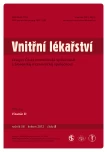D vitamin and immunity
Authors:
I. Šterzl
Authors‘ workplace:
Ústav imunologie a mikrobiologie, 1. LF UK, přednostka prof. RNDr. Libuše Kolářová, CSc.
; Endokrinologický ústav Praha, ředitelka RNDr. Běla Bendlová, CSc.
Published in:
Vnitř Lék 2012; 58(5): 405-410
Category:
Appendix: Vitamin D
Overview
Active vitamin D3 is a key factor in many pathological states. In this review its influence on the immune system will be discussed, especially in the scope of innate and adaptive immunity. D3 has a crucial importance in defense against infections and in development of immunopathological reactions, especially in autoimmunity.
Key words:
vitamin D – innate immunity – adaptive immunity – autoimmunity – infections
Sources
1. Šterzl I. Přehledná imunoendokrinologie. Praha: Maxdorf 2006.
2. Mathieu C, Van Etten E, Overbergh L et al. Vitamin D3 in Control of Immune Response. In: Geenen V, Chrousos G (eds). Immunoendocrinology in Health and Disease. New York: Marcel Dekker 2006.
3. Adams JS, Ren S, Liu PT et al. Vitamin d-directed rheostatic regulation of monocyte antibacterial responses. J Immunol 2009; 182: 4289–4295.
4. Stoffels K, Overbergh L, Giulietti A et al. Immune regulation of 25-hydroxyvitamin-D3-1α-hydroxylase in human monocytes. J Bone Miner Res 2006; 21: 37–47.
5. Hewison M. Vitamin D and the immune system: new perspectives on an old theme. Endocrinol Metab Clin North Am 2010; 39: 365–379.
6. Cantorna MT, Mahon BD. Mounting evidence for vitamin D as an environmental factor affecting autoimmune disease prevalence. Exp Biol Med (Maywood) 2004; 229: 1136–1142.
7. Wang TT, Nestel FP, Bourdeau V et al. Cutting edge: 1,25-dihydroxyvitamin D3 is a direct inducer of antimicrobial peptide gene expression. J Immunol 2004; 173: 2909–2912.
8. Peric M, Koglin S, Kim SM et al. IL-17A enhances vitamin D3-induced expression of cathelicidin antimicrobial peptide in human keratinocytes. J Immunol 2008; 181: 8504–8512.
9. Sadeghi K, Wessner B, Laggner U et al. Vitamin D3 down-regulates monocyte TLR expression and triggers hyporesponsiveness to pathogen-associated molecular patterns. Eur J Immunol 2006; 36: 361–370.
10. Albert PJ, Proal AD, Marshall TG. Vitamin D: the alternative hypothesis. Autoimmun Rev 2009; 8: 639–644.
11. Hewison M, Freeman L, Hughes SV et al. Differential regulation of vitamin D receptor and its ligand in human monocyte-derived dendritic cells. J Immunol 2003; 170: 5382–5390.
12. Karmali R, Hewison M, Rayment N et al. 1,25(OH)2D3 regulates c-myc mRNA levels in tonsillar T lymphocytes. Immunology 1991; 74: 589–593.
13. Mahon BD, Wittke A, Weaver V et al. The targets of vitamin D depend on the differentiation and activation status of CD4 positive T cells. J Cell Biochem 2003; 89: 922–932.
14. Topilski I, Flaishon L, Naveh Y et al. The anti-inflammatory effects of 1,25-dihydroxyvitamin D3 on Th2 cells in vivo are due in part to the control of integrin-mediated T lymphocyte homing. Eur J Immunol 2004; 34: 1068–1076.
15. Overbergh L, Decallonne B, Waer M et al. 1α,25-dihydroxyvitamin D3 induces an autoantigen-specific T-helper 1/T-helper 2 immune shift in NOD mice immunized with GAD65 (p524-543). Diabetes 2000; 49: 1301–1307.
16. Harrington LE, Mangan PR, Weaver CT. Expanding the effector CD4 T-cell repertoire: the Th17 lineage. Curr Opin Immunol 2006; 18: 349–356.
17. Barrat FJ, Cua DJ, Boonstra A et al. In vitro generation of interleukin 10-producing regulatory CD4(+) T cells is induced by immunosuppressive drugs and inhibited by T helper type 1 (Th1)- and Th2-inducing cytokines. J Exp Med 2002; 195: 603–616.
18. Urry Z, Xystrakis E, Richards DF et al. Ligation of TLR9 induced on human IL-10-secreting Tregs by 1α,25-dihydroxyvitamin D3 abrogates regulatory function. J Clin Invest 2009; 119: 387–398.
19. Meehan TF, DeLuca HF. CD8(+) T cells are not necessary for 1α,25-dihydroxyvitamin D(3) to suppress experimental autoimmune encephalomyelitis in mice. Proc Natl Acad Sci USA 2002; 99: 5557–5560.
20. Sigmundsdottir H, Pan J, Debes GF et al. DCs metabolize sunlight-induced vitamin D3 to „program“ T cell attraction to the epidermal chemokine CCL27. Nat Immunol 2007; 8: 285–293.
21. Lemire JM, Adams JS, Sakai R et al. 1α,25-dihydroxyvitamin D3 suppresses proliferation and immunoglobulin production by normal human peripheral blood mononuclear cells. J Clin Invest 1984; 74: 657–661.
22. Arnson Y, Amital H, Shoenfeld Y. Vitamin D and autoimmunity: new aetiological and therapeutic considerations. Ann Rheum Dis 2007; 66: 1137–1142.
23. Linker-Israeli M, Elstner E, Klinenberg JR et al. Vitamin D(3) and its synthetic analogs inhibit the spontaneous in vitro immunoglobulin production by SLE-derived PBMC. Clin Immunol 2001; 99: 82–93.
24. Ramagopalan SV, Maugeri NJ, Handunnetthi L et al. Expression of the multiple sclerosis-associated MHC class II Allele HLA-DRB1*1501 is regulated by vitamin D. PLoS Genet 2009; 5: e1000369.
25. Munger KL, Levin LI, Hollis BW et al. Serum 25-hydroxyvitamin D levels and risk of multiple sclerosis. JAMA 2006; 296: 2832–2838.
26. Andjelkovic Z, Vojinovic J, Pejnovic N et al. Disease modifying and immunomodulatory effects of high dose 1α (OH) D3 in rheumatoid arthritis patients. Clin Exp Rheumatol 1999; 17: 453–456.
27. Hyppönen E, Läärä E, Reunanen A et al. Intake of vitamin D and risk of type 1 diabetes: a birth-cohort study. Lancet 2001; 358: 1500–1503.
28. Blaney GP, Albert PJ, Proal AD. Vitamin D metabolites as clinical markers in autoimmune and chronic disease. Ann N Y Acad Sci 2009; 1173: 384–390.
Labels
Diabetology Endocrinology Internal medicineArticle was published in
Internal Medicine

2012 Issue 5
Most read in this issue
- Vitamin D metabolism
- Vitamin D and neurological diseases
- Eyelids with yellow granulomas and cough – periocular xanthogranuloma associated with adult-onset asthma. A case study and an overview of clinical forms of juvenile xanthogranuloma and its therapy
- Scoring systems to evaluate prognosis of community-acquired pneumonias
